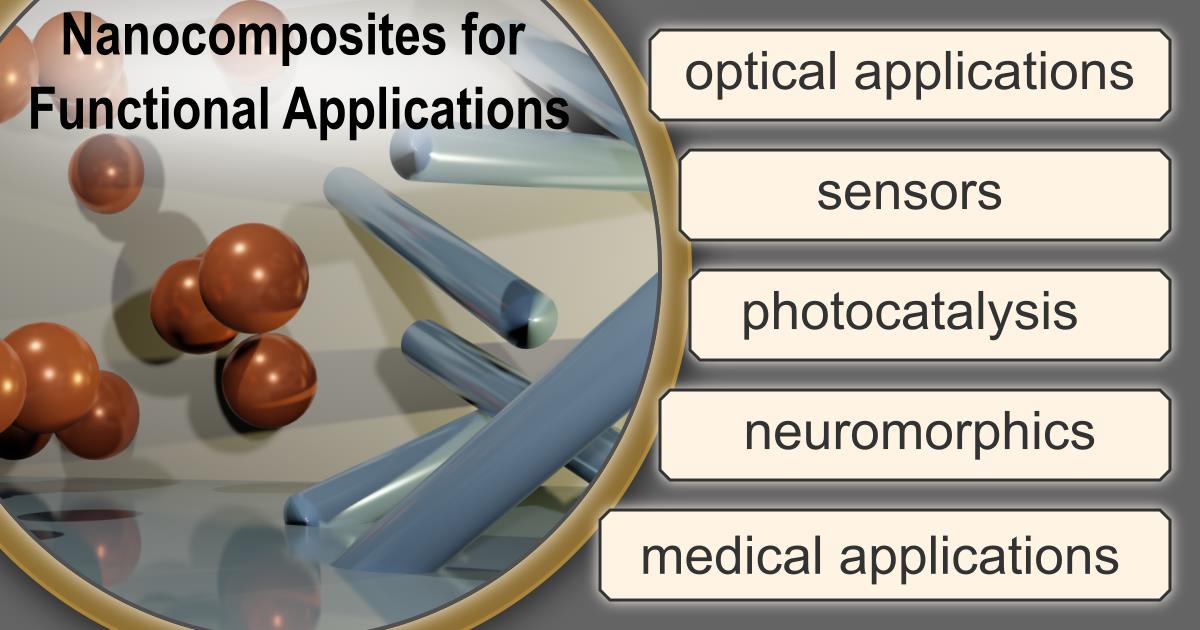Nanocomposites for Functional Applications
A special issue of Materials (ISSN 1996-1944). This special issue belongs to the section "Advanced Nanomaterials and Nanotechnology".
Deadline for manuscript submissions: closed (20 July 2024) | Viewed by 3277

Special Issue Editors
Interests: nanoparticles; functional nanocomposites; vapor phase deposition; X-ray spectroscopy; functional adsorbates
Interests: memristive switching; nanocomposites; nanoparticles
Special Issues, Collections and Topics in MDPI journals
Special Issue Information
Dear Colleagues,
Recent decades have seen research, development, and applications of nanomaterials offering novel and outstanding properties based on their nano-size. In this context, nanocomposites consisting of a nanocomponent, e.g., nanoparticles, nanofibers or nanosheets, typically in a polymeric or ceramic matrix are heavily investigated. Such nanocomposites possess outstanding properties and are particularly interesting for a multitude of different functional applications. Among others, these include optical properties based on, e.g., plasmonic absorption of nanoparticles which can be used for structural colours or thin-film solar absorption. Another field is the use of nanocomposites in sensors for gases, vapours or biomolecules, taking advantage of the sensitive electronic properties. Additionally, the inclusion of plasmonic and/or catalytically active nanoparticles has greatly enhanced the performance of photocatalytic materials. A rather new field is the application of nanocomposites in neuromorphic computing where the changes in electrical properties allow to emulate brain-like functions. Lastly, the unique combination of functional properties also makes nanocomposites interesting for medical applications, e.g., as antibacterial coatings or for controlled drug release. In this Special Issue, we would like to cover nanocomposites from their preparation and the characterization of their unique properties, up to the many different possible applications.
Dr. Thomas Strunskus
Dr. Alexander Vahl
Guest Editors
Manuscript Submission Information
Manuscripts should be submitted online at www.mdpi.com by registering and logging in to this website. Once you are registered, click here to go to the submission form. Manuscripts can be submitted until the deadline. All submissions that pass pre-check are peer-reviewed. Accepted papers will be published continuously in the journal (as soon as accepted) and will be listed together on the special issue website. Research articles, review articles as well as short communications are invited. For planned papers, a title and short abstract (about 250 words) can be sent to the Editorial Office for assessment.
Submitted manuscripts should not have been published previously, nor be under consideration for publication elsewhere (except conference proceedings papers). All manuscripts are thoroughly refereed through a single-blind peer-review process. A guide for authors and other relevant information for submission of manuscripts is available on the Instructions for Authors page. Materials is an international peer-reviewed open access semimonthly journal published by MDPI.
Please visit the Instructions for Authors page before submitting a manuscript. The Article Processing Charge (APC) for publication in this open access journal is 2600 CHF (Swiss Francs). Submitted papers should be well formatted and use good English. Authors may use MDPI's English editing service prior to publication or during author revisions.
Keywords
- nanomaterials
- composites
- synthesis
- advanced manufacturing
- coating
- optical
- thermal
- electrical
- wettability
- stimuli-responsive
- memristive
Benefits of Publishing in a Special Issue
- Ease of navigation: Grouping papers by topic helps scholars navigate broad scope journals more efficiently.
- Greater discoverability: Special Issues support the reach and impact of scientific research. Articles in Special Issues are more discoverable and cited more frequently.
- Expansion of research network: Special Issues facilitate connections among authors, fostering scientific collaborations.
- External promotion: Articles in Special Issues are often promoted through the journal's social media, increasing their visibility.
- Reprint: MDPI Books provides the opportunity to republish successful Special Issues in book format, both online and in print.
Further information on MDPI's Special Issue policies can be found here.







